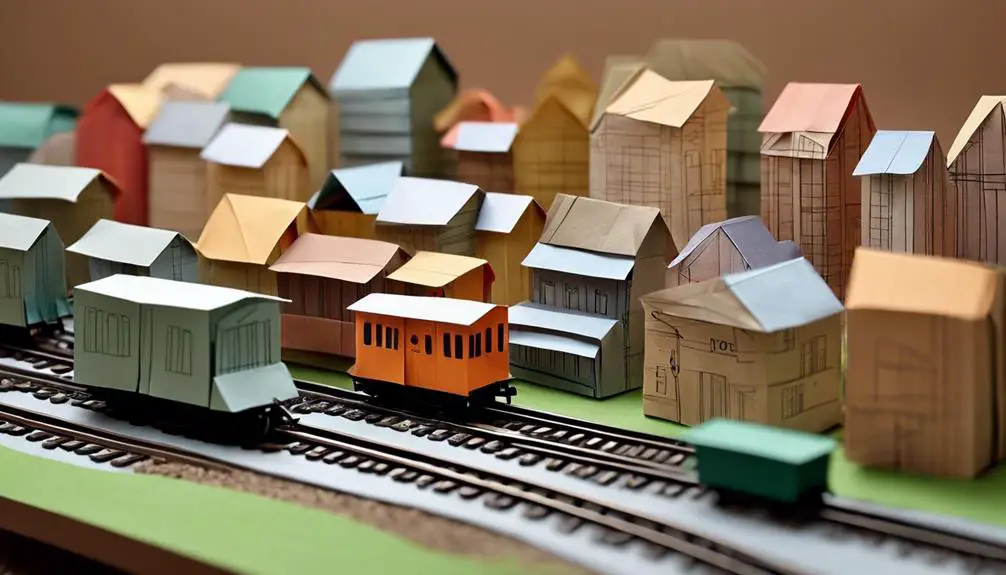Living near train tracks can be both exciting and challenging. On the bright side, you have easy access to public transportation, a vibrant urban vibe, and a chance to indulge in train spotting and photography. However, there are downsides too, like noisy passing trains, disruptions to your daily routines, safety concerns near railway crossings, vibrations, and possibly a decrease in property value. Yet, there are ways to cope, from aligning your activities with train schedules to installing noise-canceling features. Understanding the pros and cons of this unique living situation can help you make informed decisions about where you call home.
Takeaways
- Enhanced public transportation access and connectivity.
- Vibrant urban atmosphere and historical significance.
- Noise disturbances and safety concerns near tracks.
- Potential decrease in property value.
- Opportunity for train spotting and photography.
Benefits of Proximity to Train Tracks
Living near train tracks offers a multitude of advantages that can greatly enhance your daily life and overall convenience. The proximity to train tracks presents you with excellent transportation options, providing faster travel times than cars or buses. This not only reduces commute stress but also saves you valuable time. Train tickets are often budget-friendly, making them a cost-effective choice for your daily travels. Additionally, being close to train tracks allows you convenient access to various destinations, opening up a world of travel opportunities for you.
Moreover, living near train tracks can positively impact the environment. Trains are an efficient mode of transportation that reduces environmental harm compared to individual car use. Additionally, the presence of train tracks can lead to community development, with potential increases in property value and vibrancy in the neighborhood. So, not only do you enjoy convenient transportation and travel possibilities, but you also contribute to a more sustainable and thriving community by residing near train tracks.
Noise Pollution Concerns

Exposure to constant noise disturbances from passing trains near your residence can pose significant concerns for your sleep quality and overall well-being. Living close to train tracks means you're likely familiar with the loud train horns, rumbling engines, and screeching wheels that can disrupt your peace. This noise pollution doesn't just affect your tranquility; it can also lead to serious health issues.
The disruptions caused by night-time train operations can mess with your sleep patterns, potentially resulting in chronic sleep deprivation. Additionally, the unpredictable noises like squeals and whistles can take a toll on your mental health, causing cognitive disruptions that impact your daily life.
Residents living in proximity to train tracks may experience elevated stress levels due to the constant exposure to train vibrations and noise. This heightened stress can even lead to issues like insomnia and cognitive disruptions. Hence, it's essential to contemplate the potential health risks associated with living near these noisy tracks.
Impact on Property Value

Considering the proximity to train tracks, property values for homes in such locations often face challenges due to lower demand and potential buyer concerns. Living near train tracks can impact the resale values of properties, as the noise concerns and safety issues associated with trains passing by can deter potential buyers.
The marketability of homes near train tracks may be affected, leading to longer selling times and decreased interest from buyers. Market fluctuations also play a role in determining property value, requiring careful consideration before purchasing a home close to train tracks.
It's important to research the market trends and understand the long-term investment potential when buying a house in such a location. While the lower demand and various concerns may pose obstacles, being well-informed about property values, market dynamics, and potential challenges can help in making a sound decision regarding buying or selling a home near train tracks.
Safety Considerations Near Railways

When living close to railway tracks, it's important to prioritize safety considerations to reduce potential risks and guarantee personal well-being.
Safety risks near railways can include accidents, derailments, and potential collisions with trains. The proximity to train tracks heightens the likelihood of accidents involving pedestrians and vehicles, making safety precautions such as barriers, warning signs, and fences essential in these areas.
Train horns, while necessary for safety, can also be disruptive to nearby residents. Understanding and following safety guidelines near train tracks is critical to prevent accidents and maintain personal well-being.
Health Risks of Living Nearby

Living in close proximity to train tracks can pose significant health risks due to constant exposure to train noise and vibrations. Here are some key points to contemplate regarding the health risks of living nearby:
- Chronic Stress: The continuous rumbling and honking of trains can elevate stress levels, leading to long-term health issues related to chronic stress.
- Impact on Mental Health: Unpredictable noises like squeals and whistles from trains can affect mental health, cognition, and sleep quality for individuals residing close to railway tracks.
- Air Quality: Diesel emissions from trains can build up in nearby areas, surpassing air quality standards and increasing the risk of cancer for those living in the vicinity.
- Nitrogen Dioxide Exposure: Studies have shown that nitrogen dioxide emissions from trains can exceed outdoor air quality limits, posing a health risk to residents near railyards.
These factors highlight the importance of contemplating the health implications of living near train tracks and the need for appropriate measures to mitigate potential risks.
Accessibility to Public Transportation

Living near train tracks enhances access to public transportation, offering residents convenient and sustainable travel options. Proximity to train stations allows for easy connections to well-connected networks, reducing commute times considerably. This accessibility to public transportation near train tracks not only promotes eco-friendly options but also encourages a shift towards sustainable modes of travel. By relying on trains as a primary means of transportation, individuals can enjoy efficient and cost-effective commuting while reducing their carbon footprint.
Living near train tracks provides the advantage of having public transportation options readily available, making daily travel more convenient and hassle-free. With train stations nearby, residents can enjoy the benefits of a well-established transportation system that offers reliable and efficient services. This accessibility not only saves time but also contributes to a more sustainable lifestyle by promoting the use of public transportation over personal vehicles. Embracing the convenience of living near train tracks means embracing a lifestyle that prioritizes eco-friendly travel options and enhanced connectivity.
Commute Advantages and Disadvantages

Enhancing your daily commute, residing near train tracks offers both advantages and disadvantages concerning travel convenience. Here's a breakdown to help you understand the pros and cons:
- Commute Advantages: Enjoy faster travel times compared to cars or buses, making your daily journey more efficient.
- Commuting Costs: Benefit from cost-effective train tickets, which can make commuting more affordable for residents living near train tracks.
- Convenient Accessibility: Experience the convenience of easy access to various destinations, saving you time and effort in reaching your desired locations.
- Longer Commute Times: Be aware that longer commute times to city centers may be a downside for some individuals residing near train tracks, impacting your daily schedule.
While there are definite commute benefits to living near train tracks, such as quicker travel and cost savings, it's essential to take into account drawbacks like longer commute times and limited access to amenities when making your decision.
Strategies for Coping With Train Track Living

Consider investing in soundproofing or insulation for your home near train tracks to minimize noise disturbances. By adding soundproof materials to your walls or windows, you can notably reduce the impact of train noises inside your living space. Additionally, using white noise machines or earplugs while sleeping can help create a more peaceful environment, allowing you to rest undisturbed.
To better cope with train schedules, try adjusting your daily activities to align with the times when trains pass by. This simple strategy can help you avoid disruptions and delays, making your routine more manageable. Installing noise-canceling features for your windows and doors can also contribute to creating a quieter indoor atmosphere, shielding you from the external noises.
Explore community resources or support groups for residents living near train tracks. Sharing coping strategies and experiences with others facing similar challenges can provide valuable insights and a sense of camaraderie. By implementing these coping mechanisms and utilizing available resources, you can enhance your quality of life in a train track adjacent neighborhood.
Conclusion
Living near train tracks can offer several advantages, such as convenient access to public transportation, shorter commutes, and potentially lower property prices. However, it also entails drawbacks like noise pollution, safety concerns, and potential health risks.
By evaluating the pros and cons, you can make an informed decision on whether the benefits outweigh the drawbacks. Remember to contemplate your personal preferences and lifestyle before opting to live near train tracks.

